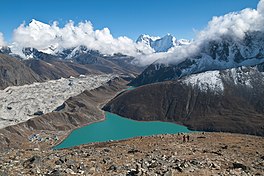| Gokyo Lakes | |
|---|---|
 Gokyo Lakes | |
| Location | Solukhumbu District |
| Coordinates | 27°58′49″N 86°40′07″E / 27.98028°N 86.66861°E |
| Basin countries | Nepal |
| Surface area | 196.2 ha (485 acres) |
| Surface elevation | 4,700–5,000 m (15,400–16,400 ft) |
| Official name | Gokyo and associated lakes |
| Designated | 13 September 2007 |
| Reference no. | 1692 [1] |
|
| |
Gokyo Lakes are oligotrophic lakes in Nepal's Sagarmatha National Park, located at an altitude of 4,700–5,000 m (15,400–16,400 ft) above sea level. Lakes and resorts were named after Gokyo Ri peak. These lakes are the world's highest freshwater lake system comprising six main lakes, of which Thonak Lake is the largest. [2] In September 2007, Gokyo and its associated wetlands of 7,770 ha (30.0 sq mi) have been designated a Ramsar site. [3]
Lake system
Gokyo Lakes are located in the Khumjung Village Development Committee of Solukhumbu District in the Sagarmatha Zone in north-eastern Nepal. Gokyo Cho, also called Dudh Pokhari, is the main lake with an area of 42.9 ha (106 acres), and the village of Gokyo lies on its eastern shore. Thonak Cho is the largest lake with an area of 65.07 ha (160.8 acres). Gyazumpa Cho is 29 ha (72 acres) in size, followed by Tanjung Cho with an area of 16.95 ha (41.9 acres), and Ngojumba Cho with an area of 14.39 ha (35.6 acres). As sources of permanent fresh water they have high hydrological value. They feed on waters from various sources, such as seepage from the Ngozumpa glacier, a stream coming from the Renjo La pass from the north-west and another stream originating from the Ngozumpa glacier in the east. These are glacier-fed freshwater wetlands and discharge water to the Dudh Kosi headway via Taujon Lake and Longabanga Lake. These lakes are deeper than previously assumed by the researchers. Fourth Lake (Thonak Cho) is the deepest lake (62.4 m) followed by Gokyo Lake which is 43 m. [4] A direct connection between the Gokyo Lake and the upper Thonak Cho and the Ngozumpa Cho has not been observed, but these lakes may be connected via underground seepage water. The Gokyo Lake system is naturally vulnerable, as it lies in an ecologically fragile and unstable zone. The outburst of the Ngozumpa glacier is always a threat to the existence of the lakes. [5]
The Gokyo lake system of 19 lakes is spread over an area of 196.2 ha (485 acres) lying between 4,600 and 5,100 m (15,100 and 16,700 ft). The wetland lies at the head of the Dudh Kosi, which descends from Cho Oyu. [6]
Religious significance
The Gokyo Lakes are considered sacred by both Hindus and Buddhists. About 500 Hindus take a holy bath in the lakes during the Janai Purnima festival, which usually occurs in the month of August. On an average 7,000 tourists annually visit the Gokyo Lakes. [5] The site is worshipped as the residing place of 'Nag Devata' (Snake God); a temple of the Hindu deities Vishnu and Shiva is situated at the western corner of the lake. The belief that birds and wildlife in the area should not be harmed has traditionally protected fauna. [2]
References
- ^ "Gokyo and associated lakes". Ramsar Sites Information Service. Retrieved 25 April 2018.
- ^ a b Bhuju, U. R.; Shakya, P. R.; Basnet, T. B.; Shrestha, S. (2007). Nepal Biodiversity Resource Book. Protected Areas, Ramsar Sites, and World Heritage Sites (PDF). Kathmandu: International Centre for Integrated Mountain Development, Ministry of Environment, Science and Technology, in cooperation with United Nations Environment Programme, Regional Office for Asia and the Pacific. ISBN 978-92-9115-033-5. Archived from the original (PDF) on 2011-07-26. Retrieved 2018-12-14.
- ^ Bhandari, B. B. (2009). "Wise use of Wetlands in Nepal". Banko Janakari (Special Issue February): 10–17. doi: 10.3126/banko.v19i3.2206.
- ^ Sharma, C. M., Sharma, S., Gurung, S., Bajracharya, R. M., Jüttner, I., Kang, S., Zhang, Q., Li, Q. (2012). First results on bathymetry and limnology of the Gokyo wetlands, high altitude tropical lakes, Nepal. Limnology 13:181–192.
- ^ a b WWF. "Terms Of Reference for Ascessing Vulnerability Of Sagarmatha National Park and Buffer Zone and Formulation Of The Community Based Adaptation Strategies" (PDF). WWF. Retrieved 2010-05-29.
- ^ Karki, J. B.; Siwakoti, M.; Pradhan, N. S. (2007). "High altitude Ramsar sites in Nepal: Criteria and future ahead". The Initiation. Retrieved 2010-05-29.
